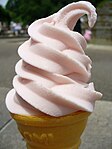Ice cream cone
 A wafer style ice cream cone with strawberry ice cream. | |
| Type | Pastry |
|---|---|
| Serving temperature | Dry or warm |
| Main ingredients | Flour, sugar |
| Variations | waffle cone, cake or wafer cone, pretzel cone, sugar cone, chocolate-coated cone, double cone, vanilla cone |
| 23 kcal (96 kJ) | |
An ice cream cone, poke or cornet is a dry, cone-shaped pastry, usually made of a wafer similar in texture to a waffle, which enables ice cream to be held in the hand and eaten without a bowl or spoon. Various types of ice cream cones include wafer (or cake) cones, waffle cones, and sugar cones.
Many novelty style cones are made, including pretzel cones and chocolate-coated cones. A variety of double wafer cone exists that allows two scoops of ice cream to be served side by side. Wafer cones are often made with a flat bottom instead of a pointed, conical shape, enabling the ice cream and "cone" to stand upright on a surface without support. These types of wafer cones are often branded as "cups".
History

Edible cones were mentioned in French cooking books as early as 1825, when Julien Archambault described how one could roll a cone from "little waffles".[1] Another printed reference to an edible cone is in Mrs A. B. Marshall's Cookery Book, written in 1888 by Agnes B. Marshall (1855–1905) of England. Her recipe for "Cornet with Cream" said that "the cornets were made with almonds and baked in the oven, not pressed between irons".[2][3]
In the United States, ice cream cones were popularized in the first decade of the 20th century. On December 13, 1904, a New Yorker named Italo Marchioni received U.S. patent No. 746971 for a mold for making pastry cups to hold ice cream.[4] Marchioni claimed that he has been selling ice cream in edible pastry holders since 1896. However, Marchioni's patent was not for a cone and he lost the lawsuits that he later filed against cone manufacturers for patent infringement.
In St. Louis, Missouri during the 1904 Saint Louis Exposition, the Banner Creamery's owner George Bang was selling ice cream. Allegedly, he ran out of bowls and was given rolled-up waffles to serve it in instead or it might be Ernest A. Hamwi, a waffle maker at the World Fair, as the first inventor.[5] According to the Dumar's web site; Abe Dumar introduced the two venders and proposed the two collaborate. Abe invented the machine that makes the cones. http://www.doumars.com
Commercial cones
The earliest cones were rolled by hand, from hot and thin wafers, but in 1912, Frederick Bruckman, an inventor from Portland, Oregon, patented a machine for rolling ice cream cones. He sold his company to Nabisco in 1928, which is still producing ice cream cones as of 2012. Independent ice-cream providers such as Ben & Jerry's make their own cones.
The Joy Ice Cream Cone Company, located in Hermitage, PA, was founded in 1917 and began to mass-produce baked ice cream cones to sell to restaurants, as well as the everyday consumer. The company handles 1.5 billion ice cream cones a year. It is said that the company is the largest ice cream cone maker in the world as of 2009.[6]
Pre-filled cones
In 1928, J.T. "Stubby" Parker of Fort Worth, Texas created an ice cream cone that could be stored in a grocer's freezer, with the cone and the ice cream frozen together as one item.[7] He formed The Drumstick Company in 1931 to market the product, and in 1991 the company was purchased by Nestle.
In 1959, Spica, an Italian ice cream manufacturer based in Naples, invented a process whereby the inside of the waffle cone was insulated from the ice cream by a layer of oil, sugar and chocolate. Spica registered the name Cornetto in 1960. Initial sales were poor, but in 1976 Unilever bought out Spica and began a mass-marketing campaign throughout Europe. Cornetto is now one of the most popular ice creams in the world.
In 1979, a patent for a new packaging design by David Wienstien led to easier transportation of commercial ice cream cones. Wienstien's design enabled the ice cream cone to be wrapped in a wax paper package. This made the cones more sanitary while also preventing the paper wrapper from falling off during transportation, or from becoming stuck to the cone.[8]
-
Sugar cones
-
Unwrapped pre-filled cone
-
Soft serve ice cream in a wafer style cone
-
Sugar cone dipped in rainbow sprinkles
-
A food vendor in Korea that serves pasta in waffle cones
-
Waffle cones
See also
References
- ^ Julien Archambault, Le Cuisinier économe ou Élémens nouveaux de cuisine, de pâtisserie et d'office, Librairie du commerce, Paris, 1825, page 346.
- ^ Stradley, Linda. "History of Ice Cream Cone". What's Cooking America. Retrieved 2008-05-13.
- ^ Weir, Robert. "An 1807 Ice Cream Cone: Discovery and Evidence". Historic Food. Retrieved 2008-05-13.
- ^ "United States Patent and Trademark Office". Retrieved 5 October 2012.
- ^ "Ice cream". Encyclopedia of New Jersey. 2004.
- ^ Mans, Jack (1 June 2009). "Labler is a Sweet Solution for Ice Cream Cone Maker". Packaging Digest. 46 (6): 38–41. Retrieved 12 October 2012.
- ^ Funderburg, Anne Cooper. Chocolate, Strawberry, and Vanilla: A History Of American Ice Cream. Popular Press. Retrieved June 10, 2012.
- ^ "The United States Patent and Trademark Ofice". Retrieved 11 October 2012.







